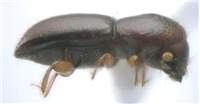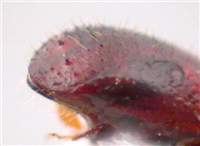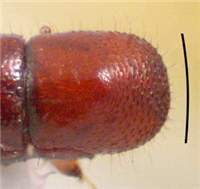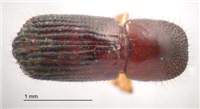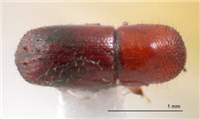Diagnosis
Middle size, reddish to black. Pronotum slightly to distinctly rectangular, with anterolateral corners slightly inflated. Elytral declivity with interstria 1 mostly divergent, with one distinct pair and several smalle tubercles.
Similar to Xyleborus, but protibial edge rounded, with numerous small denticles, pronotum obliquely rectangular.
Distribution
Currently only three species are included in the genus. Two of them are widespread: Wallacellus piceus Wallacellus similis are common throughout Africa, South Asia, and Oceania. Wallacellus striatulus occurs in New Guinea.
Biology
Usually in larger branches or trunks, most common in moist habitats.
Taxonomy
Monophyly has not been tested using molecular methods. Species previously included in Euwallacea and Xyleborus.
Detailed description
Eyes shallowly emarginate, or deeply emarginate, sometimes almost disjunct, upper part smaller than lower part. Antennal club variable, more-less circular shape, or taller than wide, club type two (obliquely truncated, segment 2 visible on posterior side), or three (with segment 1 straight or convex). Segment 1 of club dominant, covering most of posterior face, its margin circular around club or straight anteriad (may be slightly concave or convex), mostly costate, may appear softer on posterior side. Segment 2 visible on both sides, soft or partly corneous on anterior side, or corneous on both sides of club, but always thin and sinuate. Segment 3 partly visible on posterior side of club. Segment 1 of antennal funicle shorter than pedicel, only in one species longer than pedicel. Funicle 4-segmented, scapus regularly thick. Frons above epistoma mostly smooth, alutaceous, with minor punctures, or rugged, coarsely punctate. Submentum slightly impressed, or deeply impressed, shaped as very narrow triangle. Anterior edge of pronotum with no conspicuous row of serrations or with distinct row of serrations. Pronotum from lateral view of basic shape (type 0), or tall (type 2), or elongated, with low summit (type 7), from dorsal view subquadrate (type 3), or elongated and subrectangular (type 8). Pronotal disc shining or smoothly alutaceous, with small punctures, lateral edge of pronotum obliquely costate. Procoxae contiguous, prosternal posterocoxal process tall and pointed, or conical and slightly inflated. Tuft on pronotal basis associated with mesonotal mycangium absent, setae on elytral bases associated with elytral mycangium absent. Scutellum flat, flush with elytra. Elytral bases straight, with oblique edge, elytral disc longer than declivity and slightly or distinctly convex, punctures on elytral disc in strial lines. Lateral profile of elytral declivity slowly descending, often flat, dorsal profile of elytral apex broadened laterally, with expanded costa (except W. similis). Elytral declivity with few setae or scales, not conspicuously pubescent. Posterolateral declivital costa ending in 7th interstriae. Surface of declivity covered with uniform granules, or several tubercles on interstriae 2, 3 and beyond and no tubercles on interstria 1 (sutural), or several tubercles on interstriae 1, 3 and beyond and no tubercles on interstria 2. In most species surface of elytra is flat, elytra of W. striatulus covered with strial ridges and interstrial furrows. First interstriae parallel on disc but broadened towards apex of elytra, where it bears granules or tubercles. Protibiae with evenly rounded edge, protibial denticles small, bases of denticles not enlarged, usually between 6 and 8 protibial denticles present. Posterior side of protibia flat. Body length 2.1-2.6 mm. Uniformly light brown to red and opalescent to dark brown or black.

